Fashion Merchandising and Design students explore diversity, sustainability in Detroit Month of Design
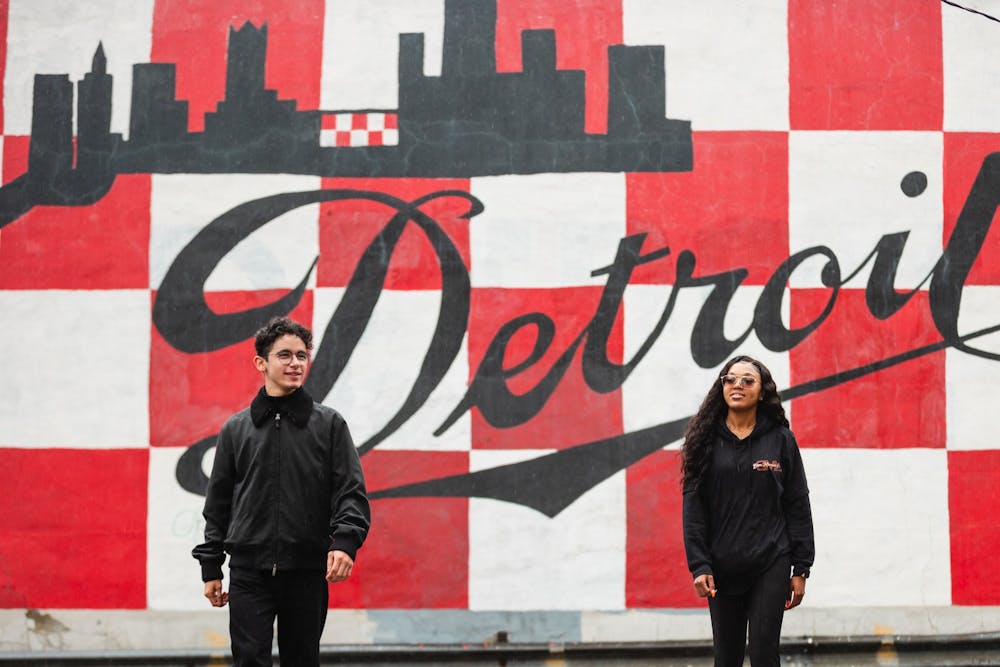
Courtesy Photo from Adam Sparkes, University Communications: Pablo Covarrubias (left) and LaDyra Lyte (right) pose in Detroit on Sept. 23 at the opening reception of CMU's exhibit "Fashion Future."
Central Michigan University Fashion Merchandising and Design students, faculty and alumni explored the impact of fashion in CMU's 2021 Detroit Month of Design exhibit.
“It’s been an honor to be involved with one of the largest cultural events in the state,” Fashion Merchandising and Design Professor Michael Mamp said. “It’s an opportunity to bring prominence and recognition to CMU and highlight our fashion and design programs.”
In its 11th year of celebration, Detroit Month of Design gathered designers from across the state to celebrate creativity and innovation throughout the month of September. The event showcases a rich cultural history across many disciplines, as well as the fresh perspective of younger generations, Mamp said.
For the first time, CMU became involved in the celebration with the exhibit “Fashion Future” located in the CMU Detroit Center. “Fashion Future” aims to examine the future of fashion design, focusing on diversity, equity, inclusion and sustainability.

Courtesy Photo from Adam Sparkes, University Communications: Mamp served as the faculty speaker at the opening reception after personally coordinating CMU's involvement in Detroit Month of Design.
“It’s impossible to ignore these issues in the world when we’re confronted so regularly by the injustices faced in our society based upon someone’s race or gender; and watching the effects of climate change on the world we live in,” Mamp said. “These social justice issues are at the top of many of my student’s minds.”
The impact made possible through fashion and design is often underestimated, Mamp said. Clothing is an incredibly personal art form; a walking message accompanying the wearer. Fashion can be a unique tool to explore concepts like diversity and sustainability.
Central Michigan Life spoke with two student designers featured in “Fashion Future”: Detroit senior LaDyra Lyte and Grand Rapids junior Pablo Covarrubias. The designers explored the powerful themes within their collections and the personal inspiration behind their work.
LaDyra Lyte
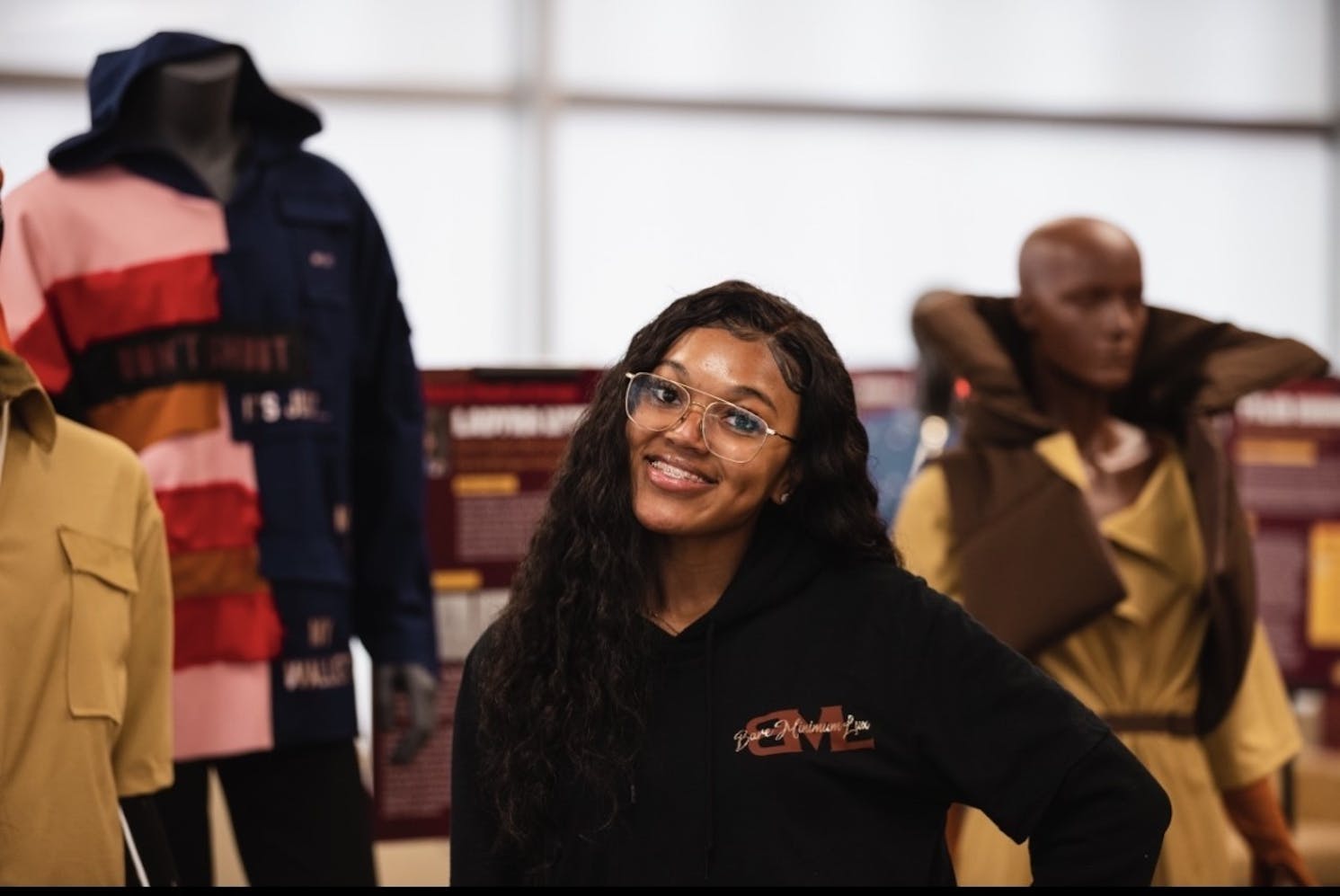
Courtesy Photo from Adam Sparkes, University Communications: Lyte poses in front of her collection "Killing Me Won't Make You King."
CM Life: What was the theme of your collection?
My collection “Killing Me Won’t Make You King” goes along with the racial injustice issues in America, as well as my faith. It is a lesson that God continues to teach me throughout every season; that someone can take my reputation, possessions, throne, everything that I have in life — even my own life — but you will never be able to take my anointing. My name will forever be on the seat that He’s placed me in. This idea came to me through prayer and personal observation. I watched myself and paid attention to what I was going through in my life and the challenges I was facing. The phrase came to me during a T.D. Jakes sermon where he was discussing that no matter what people take from you based on your race or gender, they’ll never be able to take away your path in life.
How did you represent this theme in your different looks?
“I’m Innocent” is solely based on innocent incarceration rates in the black and brown communities. It’s prison jumpsuit inspired and I think the most significant part is the graphics on the back. Inmate numbers on the back of the jacket end up spelling the word ‘Innocent’ based on the placement of each letter.
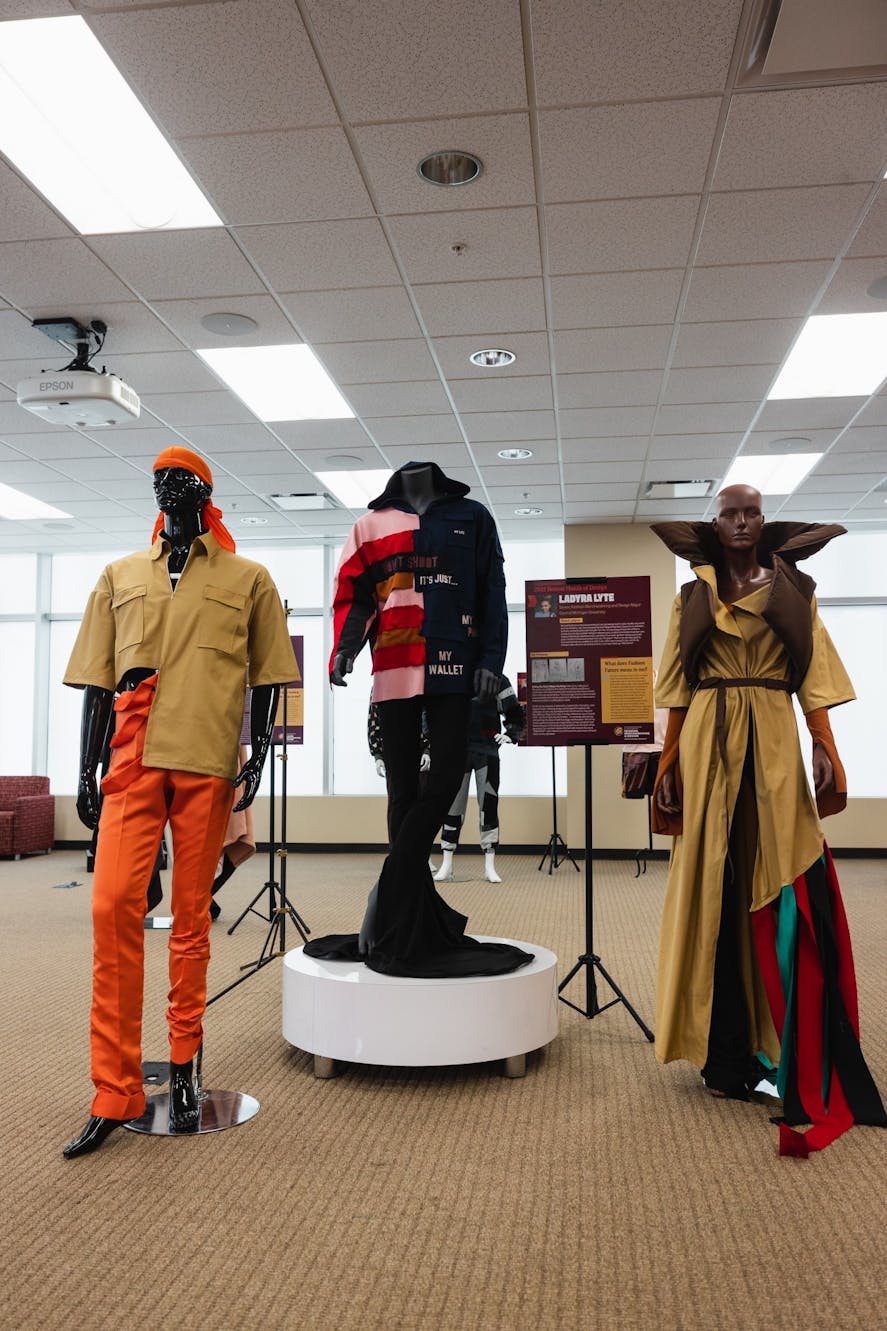
Courtesy Photo from Adam Sparkes, University Communications: Lyte's three featured looks (left to right): "I'm Innocent", "Don't Shoot" and "I Can't Breathe."
The second one is titled “Don’t Shoot” and stands as the centerpiece of the collection. I wanted to emphasize police brutality, so this one specifically focuses on the American flag with the stripes and includes graphics saying 'Don’t Shoot.' A detail I included in all of the pockets was stitching something that a black American may have grabbed before being shot or abused by the police. For example, there’s a graphic that says 'Skittles' as a reference to Trayvon Martin.
My last look is a tribute to George Floyd called “I Can’t Breathe." I created a high, tight neck-silhouette to symbolize the psychological feel of being enclosed and unable to breathe, and included graphics on the collar saying ‘I can’t breathe.' With the trench coat I wanted to give reference to the Pan-African flag with the stripes and lining of the coat. I also included references to the American flag and included a scripture that says “By his stripes we are healed.” This doubles as a reference to the strength of Jesus as well as depicting the bars of a jail cell.
Where did you draw inspiration for these pieces?
The timespan after George Floyd's death was a time of mental stress for me. On top of everything happening in the world there were also personal struggles I was dealing with in my family. I was going through a lot of trials and tribulations and it tore me down to a point where I felt unworthiness, but throughout it all I still had my faith. All of this made “Killing Me Won’t Make You King” a very personal collection for me. The outside problems were the initial motivator, but then I found myself experiencing similar events myself and it made it so much more real for me. Due to these personal issues I wasn’t able to participate in the protests like I’d wanted to, but this collection felt like my own personal protest and brought peace to the guilt I’d been feeling for not being involved more.
What message do you want the black American community to take away from your looks?
I’ve been passionate about equity and injustice issues in America forever. I’m big on identity. As African Americans I think we get in this habit of saying ‘We don’t know where we’re from’ and feeling lost. I want to be an advocate and push people to know that we have a culture, even though that origin has been stolen from us. We can be as big and vocal as we want. I want my community to understand we do have a place. We may have been brought here but we do have a culture and we’ve made something here. We need to take this environment and make it our own and get comfortable being ourselves. I want our community to get to a point where we can walk past things like discrimination and oppression and rise above them. You have nothing to lose. You already know the worst, let’s see the best that can happen now.
Pablo Covarrubias
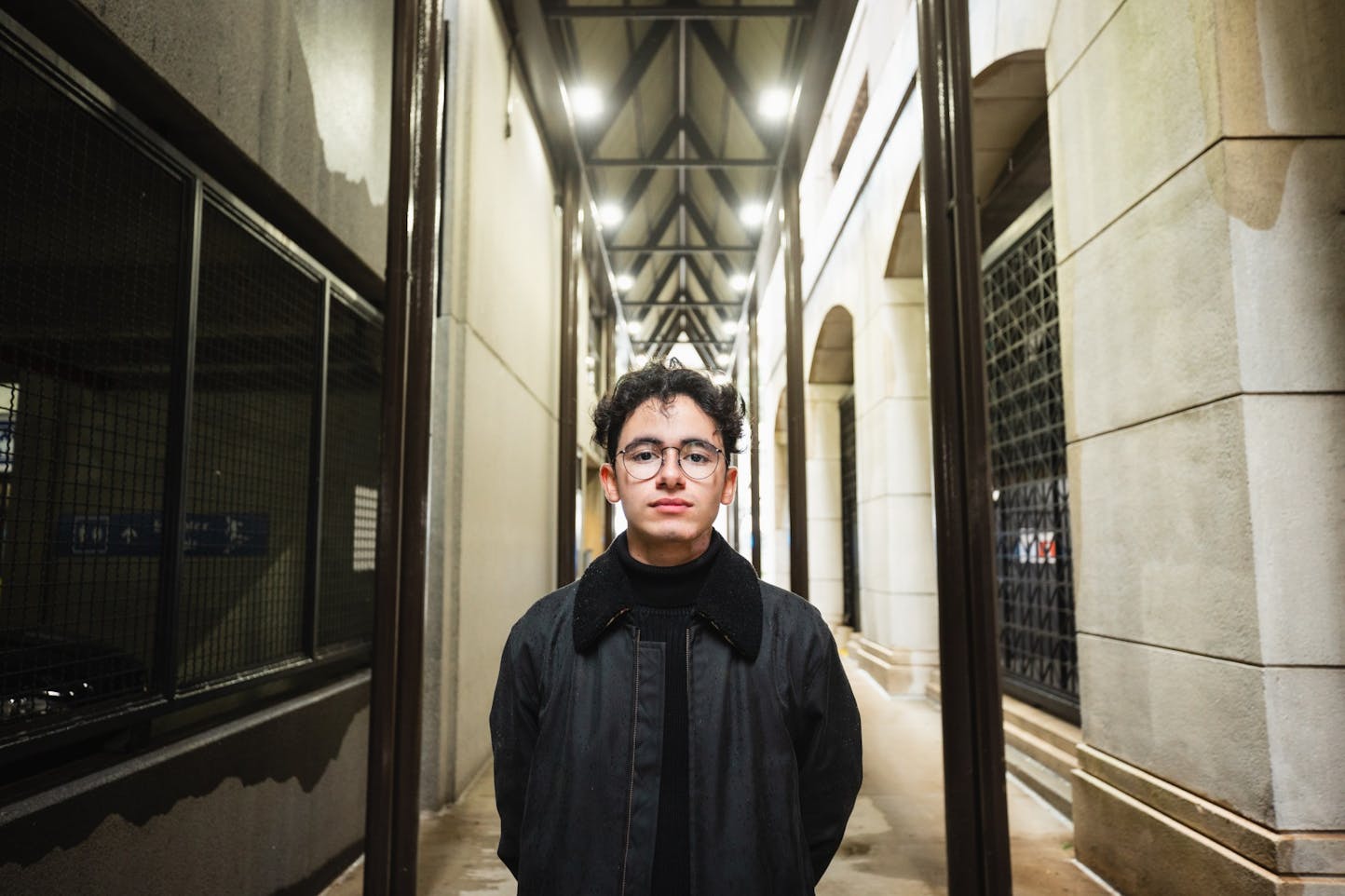
Courtesy Photo from Adam Sparkes, University Communications: Covarrubias examined sustainability in his collection titled "El Pintor."
What was the inspiration for your collection “El Pintor”?
I’ve worked with Dos Jefes Garments, which is an upcycling business based in Detroit. They go to thrift stores and buy old clothing and take it apart to make them into new clothing. It’s focused on giving old things a new life for people to enjoy. They taught me a lot because I’d never upcycled before then.
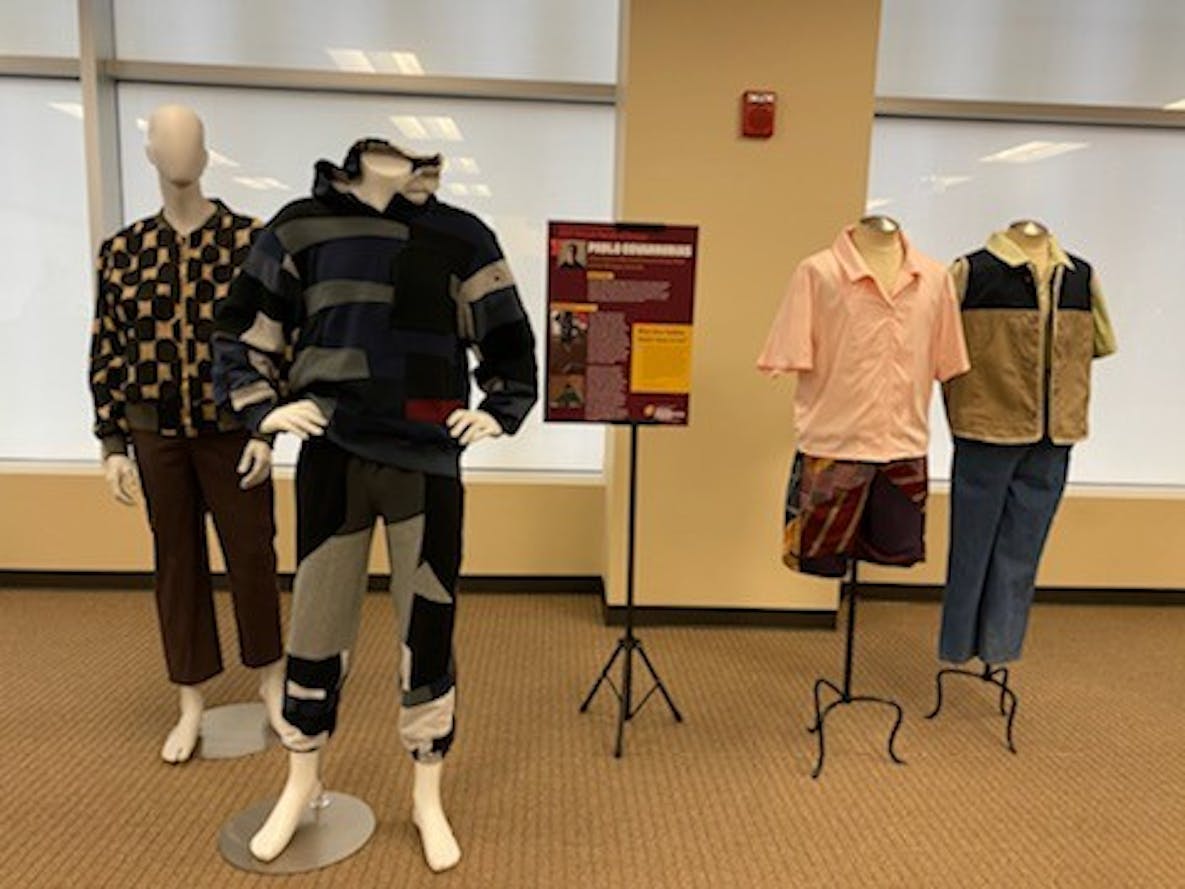
Courtesy Photo from Pablo Covarrubias: Covarrubias featured four looks in "Fashion Future", made entirely of old or damaged garments.
This brand is the reason I got into sustainability and integrated it into my design process. There’s no such thing as pure sustainability in the fashion industry, but I only ever used old clothing or scrap material to make this collection. The Dos Jefes studio is in an industrial complex of artist studios and has old art from Detroit’s hay-day that I took inspiration from. From this, I named my project ‘The Painter’ in Spanish.
What have you seen happening in the world and your life relating to sustainability?
In the past two years there’s been a huge uprise in being aware of social justice issues and sustainability. Especially sustainability in the fashion industry, which is the second most polluting industry in the world. I’m very mad. I don't want to contribute to this problem. I’ve also worked for Public Thread in the past, an upcycling business based in Grand Rapids. I was exposed to how wasteful the fashion industry is. All the fabric they use is saved from being thrown away and turned into something new. Realizing the scale of how much is thrown away by only a few small companies was eye-opening. The fashion industry used to be this beautiful, artistic thing and we’ve watched it morph into a consumerist monster where people buy just to buy, without any thought. I reformed my design philosophy and decided to design with a purpose. I want to make clothing that is made to be worn until it falls apart and get the most use out of it as possible.
What do you want young people to learn from your collection?
Educating ourselves is important. Our generation is a lot more into fashion than previous generations. Educate yourself on the harm of buying new things. Most people don’t need as much clothing as is sitting in their closet right now. Knowing the impact of pricing is also important. Clothing shouldn’t be sold how it is right now. It’s very difficult and time-intensive to make a quality piece of clothing. The price should reflect this; you're not getting scammed for higher-end clothing. Buy more thoughtfully. Don’t buy fast fashion. If you’re able to buy a shirt for $5 that means someone in the supply chain is not getting paid well or is being abused ethically. Move towards thrift shopping or using online resell environments like Depop.
How do you try to incorporate sustainability in the rest of your life?
Simple things like short showers and turning the lights off in your apartment are small things I try to do. I've stopped buying brand new clothes entirely. Also, a lot of people don’t realize that they’re over-washing their clothes. Machine washing is a huge polluter and releases microfibers. You don’t have to fully wash your garments as often as people do. Spot-cleaning and less frequent washing can make a huge difference on the environment.
What did you take away from this experience overall?
It felt like payoff. It’s been a journey to get where I am today, and I was able to see that in my collection at the exhibit. There’s a societal standard that fashion is a hobby and not a career-path. When I first told my family I was getting into fashion back in my freshman year they were a little skeptical of the idea. They wanted to know my goals and have a plan for the future. I promised I would get them results. A couple years later being featured in Detroit and my parents seeing all my hard work pay off was worth everything. I went from not knowing how to make a pattern my freshman year to making an entire collection using sustainable methods a few years later. I was able to follow through on that promise and make them proud. In Mexican culture, family is very important and making them proud is all I wanted from this experience.






